Brownlow Medal 2020: Former Saints and Roos star Nick Dal Santo dishes on what really goes on at the Brownlow
Former St Kilda and North Melbourne star Nick Dal Santo has been to his fair share of Brownlow nights. And plenty goes on off camera. From drinking games to player traditions and the after-party, he shares his experiences.
AFL News
Don't miss out on the headlines from AFL News. Followed categories will be added to My News.
At the Brownlow Medal count, in a year the Saints did pretty well, and off the back of a prelim loss to Sydney, I wasn’t allowed into the after-party.
It was 2005 and at the end of the night most people had left to head to the after-party.
Our table stayed inside the Crown Palladium until they politely asked us for the fourth time to leave.
We eventually made our way around to the after-party nightclub outside Crown, but they wouldn’t let us in as it was at capacity.
Watch the 2020 Toyota AFL Finals Series on Kayo with every game before the Grand Final Live & On-Demand. New to Kayo? Get your 14-day free trial & start streaming instantly >
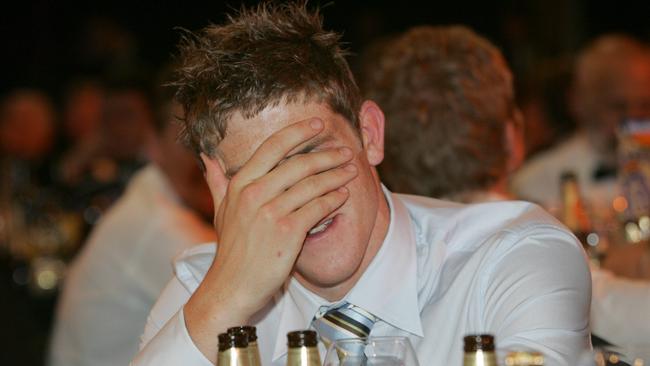
I was with teammate Matt Maguire, who was my date that year, trying to talk our way in before Eddie McGuire came walking out to leave and saw us stranded outside as we pleaded our case to the unmoved bouncer.
“Mate, surely you can let this guy come in, he was on the podium tonight,” Eddie said.
Quick as a flash the bouncer replied: “Oh, OK, no worries Ed.”
I’ve heard the after-parties have died down a little bit from what they were. It’s probably a good thing as well.
Besides, most players are a bit more tactical now. You never want to be the one caught making a fool of yourself at the after-party, so often we’d get a few rooms to stay in at Crown.
We’d go back there in a smaller group and have some drinks away from the thousand people at the Brownlow.
I always enjoyed the occasion and saw it as a fun, relaxed night, a few free beers, a nice feed and a night out with the boys and the partners. Although, in my experience, no two Brownlows are the same.
Here are a few of the different scenarios I experiences, along with what really goes on during the night.
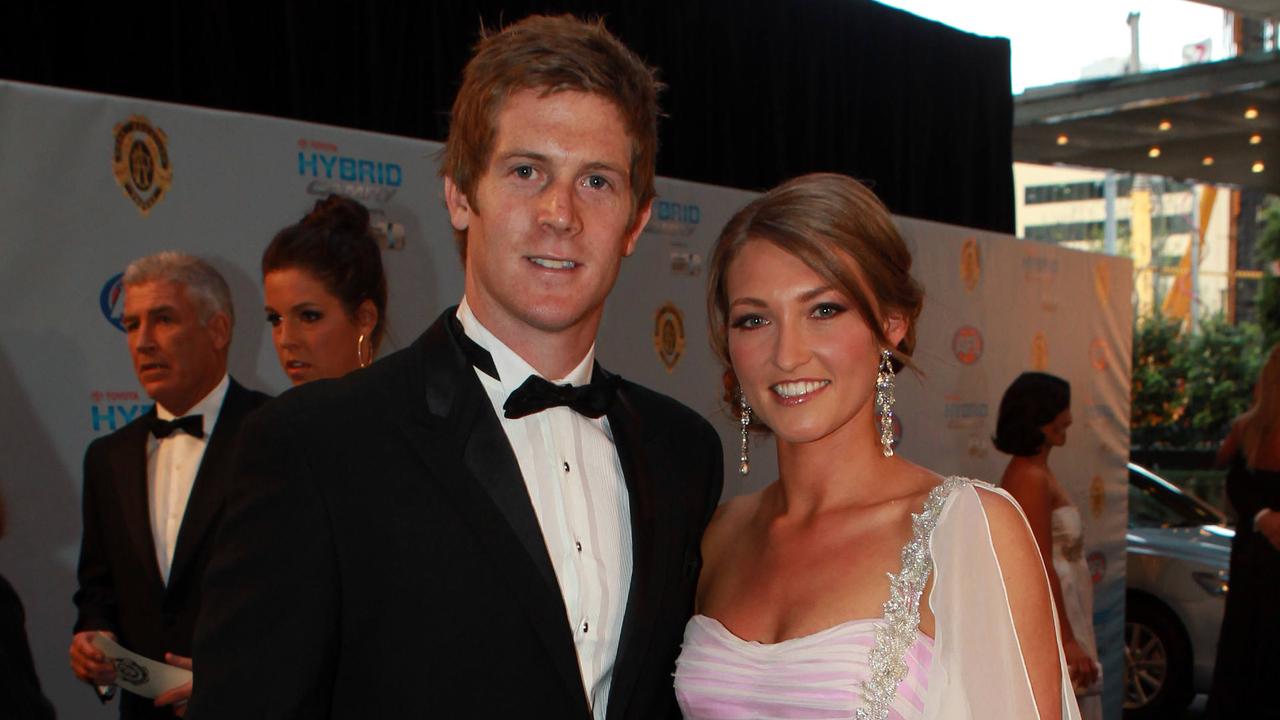
GRAND FINAL AHEAD
Let’s be honest, as a player it’s where you want to be.
You want to be playing in a grand final that week, but it certainly changes your Brownlow night in a big way.
In 2009 and 2010 I went to the Brownlow when we were playing in the grand final six days later.
You want to have a good time and relax for a moment but you don’t get that chance because you’ve often trained that day, you’ve got the grand final parade coming up in a few days and there’s a lot going on in your head.
You’ve been sipping water all night after hours of people coming around to slap you on the back and wish you well for the game so as soon as the player gets up to collect the Brownlow, you’re immediately out the door.
You’re sitting there stone cold sober just wanting to go to bed and rest.
The girls have had a couple of drinks so they’re happy, and you’re the one being the handbrake and saying “we’ve got to go”.
You’re just so conscious of your preparation for the grand final, which is hard because you’re in a place where everyone else is enjoying the party.

PLAYING HURT AT THE BROWNLOW
“I can’t do this again.”
That is all that goes through your mind as you arrive at the Brownlow as a player from a team whose season ended that weekend.
I played in five preliminary final defeats, which were followed by end-of-season drinks.
Come Brownlow night, you have a brave face on but you’re feeling very dusty because you’ve already been socialising for a few days.
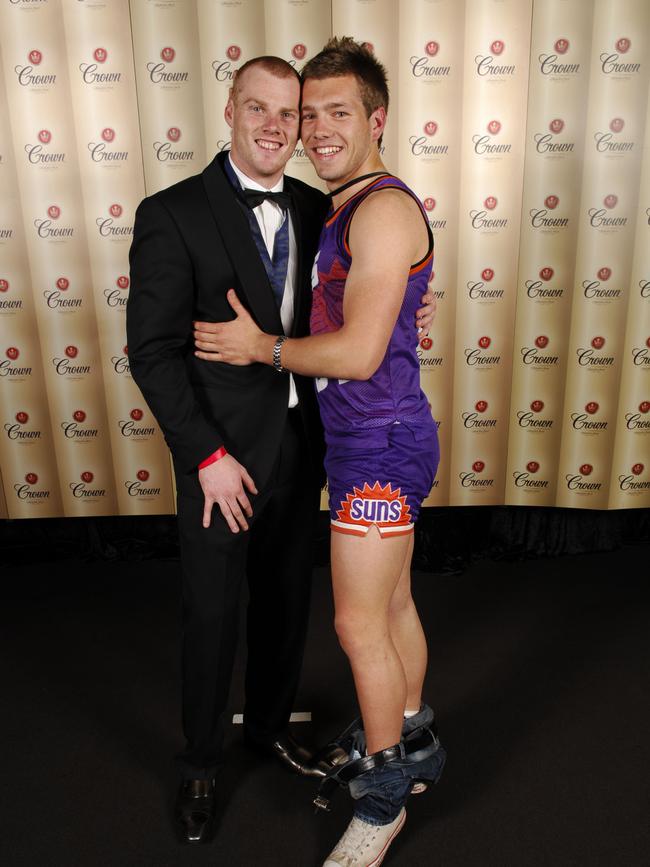
St Kilda was organised so at least we’d have the Monday off — our big day would be a Terrible Tuesday or a Wacky Wednesday to accommodate the Brownlow.
We’d spend the Saturday and the Sunday together and Monday was mercifully a day-off before the festivities started again on the Tuesday.
Some clubs weren’t as organised and its players would turn up to the Brownlow off the back of Mad Monday.
You could always tell who they were and you always felt for them
They’d have rosy cheeks, their eyes were a bit droopy, their hair a bit scruffy and their tie a bit off centre.
CUSTOMS OF THE NIGHT
There is a thing in Brownlow circles that in my experience is a tradition.
Whether you know an opposition player personally or if you’ve never met them before, you have to acknowledge them on the night.
So if you to go to the toilet, and particularly if you’re on a front table, you have to walk past about 20 tables on your way out of the room to get to the outside area..
It’s like when you’re at a race day and every trip to the loo is a five-minute walk that turns into an hour because you bump into so many familiar faces.
At the Brownlow you step outside and you miss eight rounds because you literally only have the TV commercial break time to get to the toilet and back again before they shut the doors until the next break.
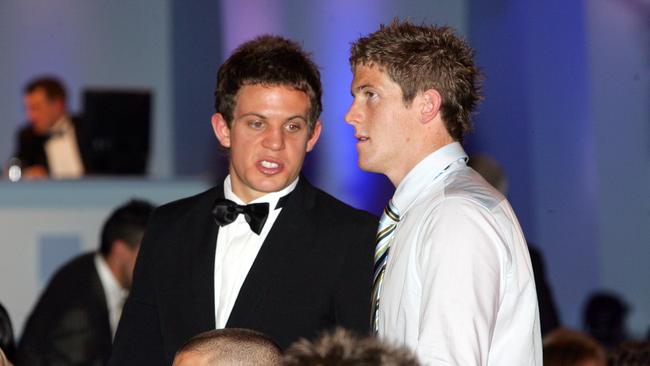
One year I ended up on the West Coast table saying g’day and sharing a drink together as I knew a few of their boys. I was there for four or five rounds which made it a bit awkward when out the corner of my eye I could see the roaming cameras pan at the Saints table looking for the vote getters. I was one of many that wasn’t in their right seats during the telecast.
Sometimes you meet players from other clubs you feel like you’ve got a lifelong bond with just from spending time together at the Brownlow. I’ve played games in following years against players I’d had beers with on the night.
Then when you’re shaking your hands post-game you’re asking them how they’ve been going like you’ve known them for years.
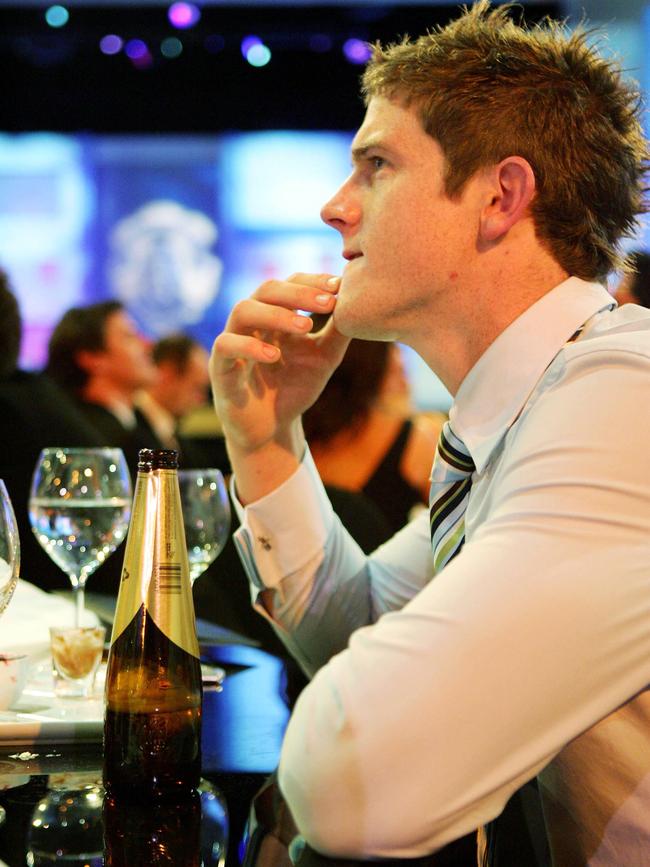
Then there are the drinking games.
Nothing’s ever official but you tend to drink if you, or the person you played on, gets a vote.
For example, if I was playing on Gary Ablett and he polled — which happened a lot — this how it went…
One vote means one thumb, two votes is two thumbs and three votes means finish your glass.
If you’re there for a big night, you have to be tactical.
The waiters are not allowed into the room until the ad breaks, so you try to stock up knowing they probably won’t get to you for the next half an hour.
At the same time, it is a long night so sipping is essential.
LITTLE SIGNS
It’s a very long day and night.
By the time the telecast of the count starts on television it is about 7.30pm.
Because they don’t want people eating on TV guests have already had their entree, main course and dessert before the telecast even starts.
You’re there at the venue from late afternoon — which all starts with the red carpet.
That is where you get your first real feel of how you are going to go that night. As you’re walking down, if the media want to speak to you then you feel like you must be around the mark.
The other telling sign is where your team is seated.
I’ve had years where we’ve been front and centre knowing the Saints were going to get a lot of votes and then I’ve had other years where we’ve been pretty much in the kitchen helping to cook the meals.
You know it’s going to be a long night when that happens.
In 2011 I finished second behind Dane Swan, but I never went in thinking I was a chance.
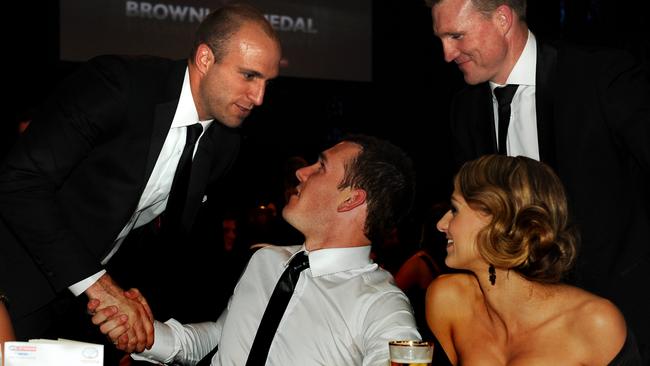
At the halfway point I got interviewed by Bruce McAvaney.
“You might need to start drinking some water,” he said.
That was the year Swan got injured mid-year, went to Utah for training and came back in super condition.
He averaged a ridiculous amount of disposals for the rest of the year, so I knew deep down I was never a chance. It was still exciting though.
There are camera crews running around so you know if you’re getting a vote or not depending on whether they’re right in your face.
As for this year, Lion Lachie Neale is the favourite and rightly so, so he can expect plenty of face time.
I’d also expect Patrick Dangerfield and Travis Boak to poll well.
MORE BROWNLOW MEDAL
Brownlow Medal betting tips: Best bets for every club
From Tiger cub to Lion king: Lachie Neale’s journey from tiny farming community of Kybybolite
Brendan Fevola opens up on day after drunken antics at 2009 Brownlow
Did mistaken identity cost Wanganeen the 2003 Brownlow?
- Simeon Thomas-Wilson
Gavin Wanganeen jokes a case of mistaken identity cost him a second Brownlow Medal, and the first ever by a Port Adelaide player.
Already a winner in 1993 as a fresh-faced defender at Essendon, the Port Adelaide legend is still perplexed at how a decade later after his best ever season he wasn’t at least sharing the medal on the gala night.
The Power star came into the 2003 count as the favourite, following Mark Williams’ decision to free him up to play midfield.
But he came away from the night in equal second – with Ben Cousins and Shane Crawford – just one vote off shared victors Nathan Buckley, Adam Goodes and Mark Ricciuto.
That effort by Wanganeen – now a board member for the Power – has been the closest a Port Adelaide player has gotten to winning the Brownlow Medal, which could change if Travis Boak can upset hot favourite Lachie Neale this year.
But in the eyes of Wanganeen, Williams and scores of Power fans, Port’s Brownlow drought should have been broken 17-years-ago.

Much of this centres around the final game of the home and away season for a Port Adelaide side that eventually lost to Collingwood in the preliminary final – a Showdown against fierce rivals Adelaide.
In the voting for both the Showdown Medal and from the umpires the top three went Ricciuto (23 disposals, 11 contested possessions, two tackles) in third, Wanganeen (20 disposals, 10 contested possessions and a goal) in second and Peter Burgoyne (22 disposals, nine contested possessions, six tackles) getting the top votes for his performance after battling a virus in the build-up.
That single vote to Ricciuto got him to the podium, while the solitary missed vote meant Wanganeen was looking on wondering what could have and perhaps what should have been after his best ever season.
“I just needed that one vote or two votes (extra) and my brother boy Peter took the three votes off me maybe the umpires got him mixed up with me,” Wanganeen said.
“A bit of a mistake it was meant to go the other way and I would have had two Brownlows but never mind that’s the way it goes.
“There is a little bit of unpredictability in the Brownlow.”
Williams is still bitterly disappointed that Wanganeen didn’t come away with a shared medal at least.
“I remember thinking Gavin should win this (the 2003 Brownlow),” Williams said.
“Anyway, very unlucky for him.”
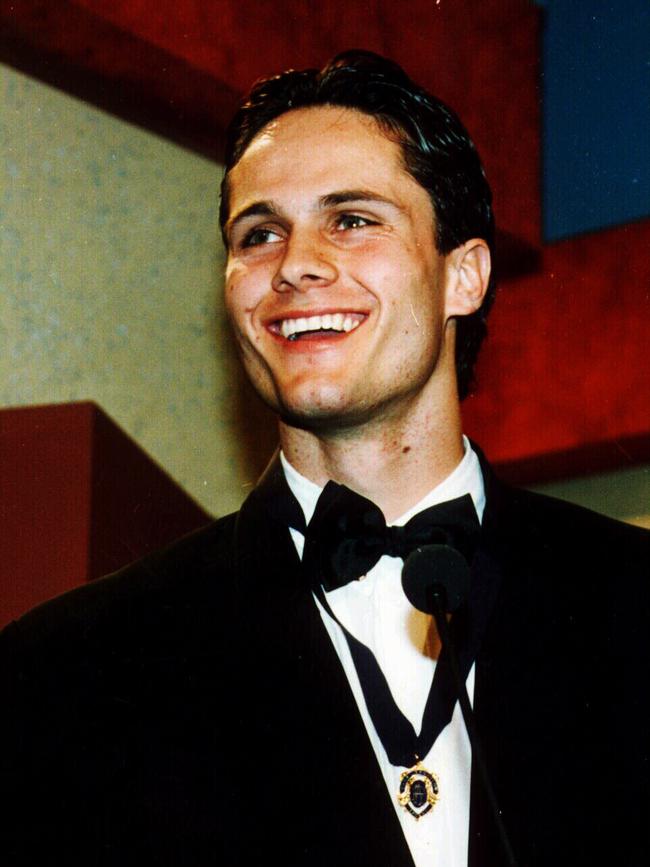
Wanganeen said it might have corrected his win in 1993, which Carlton’s Greg Williams – who won it with Sydney in 1986 – subsequently sought legal advice in a bid to be recognised as a joint winner after he didn’t poll a vote in a 44-disposal game for the Blues in their nine-goal win against Melbourne in Round 10.
“I guess you look at 93 I probably had a bit of luck go my way and winning the Brownlow so it may be fair to say the luck went against me this time,” he said.
“I thought I was a really good chance (in 2003) and unlucky to not win that one.
“It was one of those seasons, I think I went into the night and counted a few more votes than that anyway.”
The tilt at a second Brownlow Medal, 10-years after his shock win in 1993, came after the then 33-year-old Wanganeen finally got a long-awaited wish and was able to play the season in the midfield after being transformed into a play-making defender by Essendon coach Kevin Sheedy.
Wanganeen could also do some serious damage in the forward line, but it was around the ball where he wanted to play.
“When the master coach Kevin Sheedy suggests you go into defence you do it,” he said.

“But at the start of pre-season (for the 2003 season) Choco said I’m going to throw you up next year Gavin, we want to get you into the midfield and release you and let you be free.
“My ears pricked up and I thought oh yes this is going to be a great year because I had always wanted to play in the midfield.”
Williams said Wanganeen was so quick that at Alberton it seemed like the dry grass would catch on fire when he took full flight, but his aerobic capacity was sometimes lacking.
“Gavin was always used as a bit of a get out of trouble type of guy and to make an impact, but his lack of aerobic fitness was always a concern that we weren’t able to play him on ball for a long time,” Williams said.
“So he built up his tank a little bit, and at the same time we took the positives of what he can do rather than what he couldn’t do and it proved to be very successful.
“When he was 17 and I was about 31 we played on-ball/forward for the Port Magpies together and I was very keen to get as much time as I could on ball so Gavin was just there sitting there and waiting to get the nod.
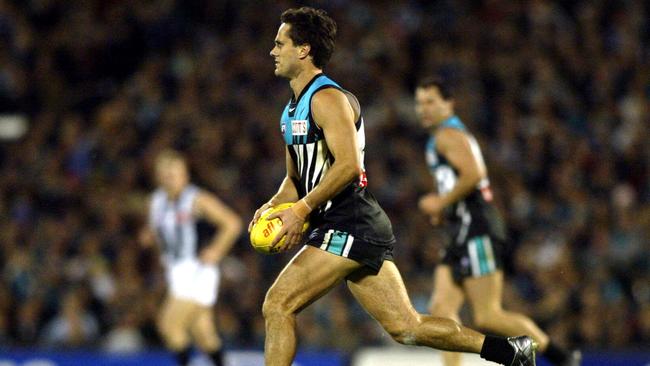
“He was ripping it up in the forward line as well so we weren’t losing too much but I always knew how much he valued the opportunity to do what he could and not sit and wait for people to give him those opportunities.”
Wanganeen wonders what could have been if he got more chances on the ball like 2003, in which he averaged just under 21 disposals a game and 17 kicks.
“Looking back on it I wish I got the chance to play even three quarters of my career in the midfield,” he said.
“As a utility you kind of wish you could settle down in one position and you’d pick the midfield if you’ve got the goods.
MORE AFL
Moneyball: Get the latest trade, draft, free agency and list news from around the AFL
“But I’m getting 30 (touches) and I’m kicking ass because that’s how desperate I am to get in the midfield and how much I loved it so imagine how I felt when I was going to get the whole year there.
“I went in as the Brownlow favourite and missed out by only one vote, so I guess that says I had a pretty good year.”
Originally published as Brownlow Medal 2020: Former Saints and Roos star Nick Dal Santo dishes on what really goes on at the Brownlow

